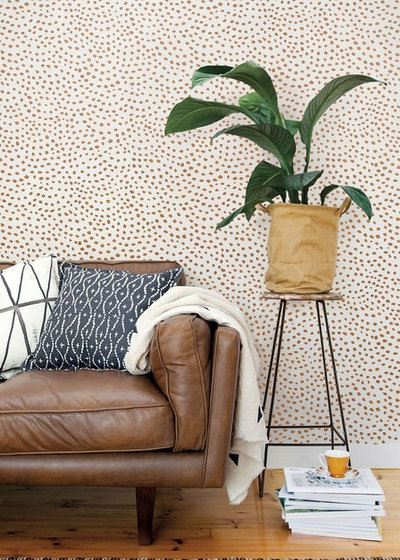Either way, stripes work beautifully with other stripes or with completely different patterns.
Mix a few different sizes of stripes, and maybe a polka dot too, and you’ve got a hard-to-go-wrong scheme with plenty of personality and energy.
Using just angular geometrics, with no curves, is one of the easiest ways to mix multiple patterns without worry.
Another easy way to mix multiple geometric patterns is to choose patterns with a similar thickness to the lines. These pillows use very different patterns, but they all contain thin lines at approximately the same scale. A single pillow in a chunky pattern might look out of place, but since they all share a similar line weight they look coordinated.
Opposites attract. Combine a neutral, angular geometric featuring triangles (or basic stripes) and let a pop of colorful floral with gentle curves play against the sharp lines.
A zebra stripe, being essentially just a variation on a basic black-and-white stripe, is a great element to toss into any design (in a small dose) to add a little organic drama.
Luckily, there are other aspects of a pattern we can look at to guide us in how to mix and match.
Color. Mixing patterns within a restrained color palette is a great way to use a variety of actual patterns without having any jarring contrast. Nautical schemes, for example, often use a variety of different fabrics, all in blue and white, to let the different lines and shapes provide the visual interest.
It’s about as classic as they come: Mixing several patterns in strict black and white virtually always works, even if the scales and styles are different. To play it extra safe, keep all the patterns at least 50 percent white so you don’t accidentally overdo the black, unless you’re going for a gothic look.
The size of a pattern can be at least as important as its style. A very small pattern can easily be missed from a distance, while a bold pattern will command attention even from across the room.
Mixing scales of patterns can be tricky, though not if you take one of these two approaches: going all different or all the same. This room uses the former approach, with a large-scale stripe on the chairs and a much-smaller-scale pattern on the rug. The chairs are clearly able to dominate, and the contrast of the almost textural rug pattern looks intentional.
Naturally, it also helps that these differing fabrics are in roughly the same color scheme as well. Combining differing strategies for mixing patterns definitely helps get a great result.
Traditional rugs. Rugs in rich, traditional patterns are a bit like stripes in that they can almost be treated like a neutral with no pattern at all. Their fine, intricate designs and rich, sophisticated colors make them easy to mix with other patterns that are either more subtle, more bold or both.
This room feels rich and sumptuous partly because it includes three diverse patterns, but to the casual glance, only the geometric wall treatment feels like a true pattern. The traditional umbrella stand and rug appear much less graphic, blending in perfectly yet holding their own.
Foolproof Plan 5: The Powerful Trio
Here’s a potent recipe: Mix a chevron or plain stripe with a smaller geometric and a cheerful floral to achieve an easy yet dramatic look.
The 60-30-10 approach. This is a great ratio for mixing two or more major patterns with a small accent. Choose a major pattern to dominate the space and let that be about 60 percent of the visible pattern, such as this large area rug. Then choose a second, coordinating pattern to be 30 percent, like these striped drapes. Lastly, let just about 10 percent be a bold, contrasting choice, such as these marbled fabric chairs, or try a mix of pillows.
The math doesn’t need to be exact, but if you clearly have a structure of dominant and non-dominant patterns, the whole set can be bold yet coherent.
Keep in mind, the pattern you’re seeing the most of shouldn’t be so bold that it becomes overwhelming when you use that much of it. The more you plan to use, the less intense the main pattern should be.
If that seems like too much for you, just stick to a simpler technique. However, keep in mind that items like pillows are easy to move between rooms (or return to the store) if you find the look isn’t quite adding up. Play with it until it feels just right, and trust your own eye.





























